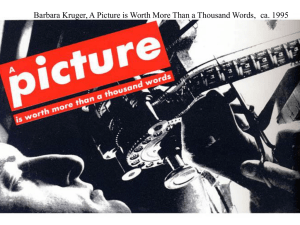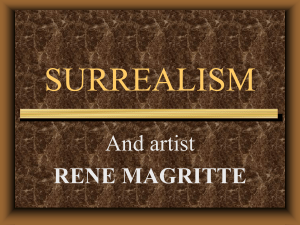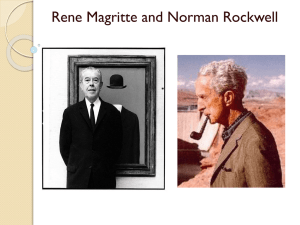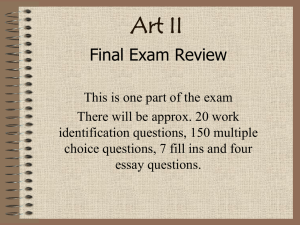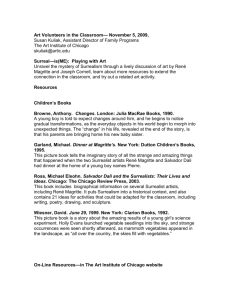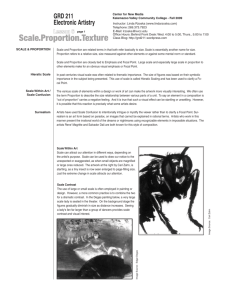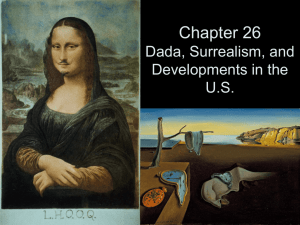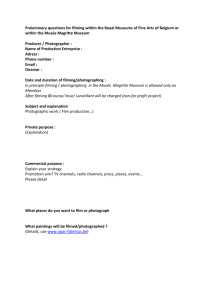Magritte PPT
advertisement
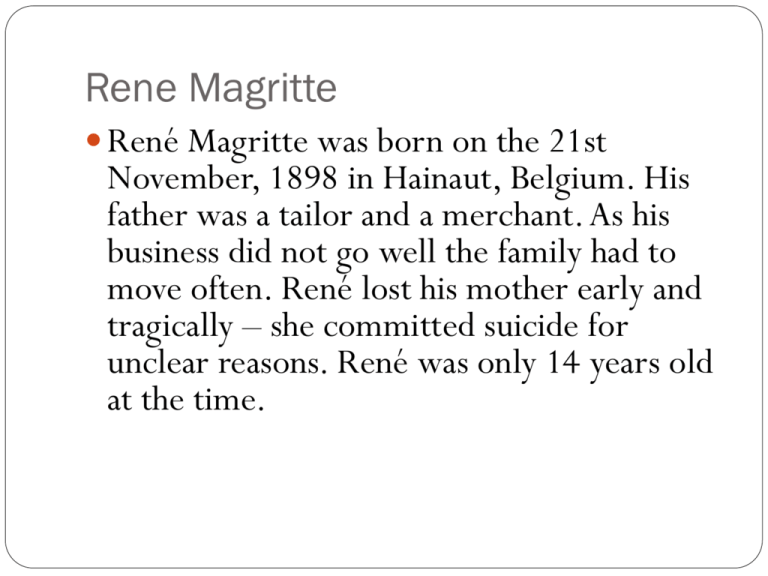
Rene Magritte René Magritte was born on the 21st November, 1898 in Hainaut, Belgium. His father was a tailor and a merchant. As his business did not go well the family had to move often. René lost his mother early and tragically – she committed suicide for unclear reasons. René was only 14 years old at the time. Rene Magritte From 1916 through 1918 Magritte studied in the Royal Academy of Arts in Brussels (Académie Royale des Beaux-Arts). He became a wallpaper designer and commercial artist. His early painting works were executed under the influence of the Cubism and Futurism (1918-20), then he was inspired by the Purists and Fernand Léger. In 1922 Magritte married Georgette Berger, with whom he first became acquainted when fifteen years old. After meeting again in 1920, she became his model and then wife. Rene Magritte The acquaintance with Giorgio de Chirico's Pittura Metafisica (Metaphysical Painting) and Dadaistic poetry constituted an important artistic turning-point for Magritte. In 1925 he came close with a group of Dadaists and co-operated in the magazines Aesophage and Marie, together with E.L.T. Mesens, Jean Arp, Francis Picabia, Schwitters, Tzara and Man Ray. Rene Magritte In 1926 Magritte painted The Lost Jockey, it is his first painting that he allowed to be labeled as "Surrealist". After his first, badly-received, one-man show in Brussels in 1927, he left for Paris. In 1927-30 Magritte lived in France, where he participated in the activities of the Surrealists, establishing a close friendship in particular with Max Ernst, Dali, André Breton and especially with Paul Eluard. The Lost Jockey 1926 Rene Magritte In Paris, Magritte's system of conceptual painting was formed, it remained almost unchanged until the end of his life. His painting manner, intentionally dry and academic, "polished in the technical sense" with precise and clean draftsmanship demonstrated a paradoxical ability to depict trustworthy an unreal, unthinkable reality. Rene Magritte In Magritte’s works the morphologically similar objects belonging to different classes, exchange some qualities or unite as hybrids (Companions of Fear. 1942, The Explanation, 1954, The Flavour of Tears, 1948); a night landscape gleams under daylit skies (The Empire of Lights 1954). Companions of Fear 1942 The Explanation 1954 The Flavour of Tears 1948 The Key to the Fields 1936 Beautiful World 1962 Hegel’s Holiday 1958 Rene Magritte Demonstrating the problems of visual perception and illusionary of images, Magritte used the symbols of mirrors, eyes, windows, stages and curtains and pictures within pictures (The False Mirror, 1935, The Key to the Fields. 1936, Beautiful World. 1962.) Rene Magritte Magritte was fond of philosophy and literature. Many of his paintings reflect his impressions of literature works, illusions and philosophical metaphors, e.g. The Giantess (after Baudelair) 1929-30; The Domain of Arnheim (after Edgar Poe) 1938; Hegel's Holiday. 1958 (homage to Hegel's dialectics). Rene Magritte In the 1940s Magritte made two attempts to change his painting style. But the so-called “vie-heureuse” or “plein-soleil” period of 1945-47, when he painted in the style of Renoir, and the “époque vache” (Cow Period) that followed in 1947-48 did not prove to be effective and the artist returned to his previous manner. Rene Magritte In the 1950s Magritte executed two fresco cycles: The Enchanted Realm for a casino in Knokke-le-Zut (1953) and The Ignorant Fairy (1957) for the Palais des Beaux-Arts in Charleroi. These monumental compositions repeat the motifs of his previous paintings. In his last year Magritte began to make sculptures of his painted images, developing the theme of correlation of mental and material realities. Magritte died of cancer at the age of 69, August 15, 1967 in Brussels. The Enchanted Realm 1953 Personal Values 1958 Personal Values 1958 The artist presents a room filled with familiar things, but he gives human proportions to these formerly unassuming props of everyday life, creating a sense of disorientation and incongruity. Inside and out are inverted by his rendering of a skyscape on the interior walls of the room. The familiar becomes unfamiliar, the normal, strange; Magritte creates a paradoxical world that is, in his own words, "a defiance of common sense." Son of Man 1964 Magritte painted it as a self-portrait. The painting consists of a man in a suit and a bowler hat standing in front of a small wall, beyond which is the sea and a cloudy sky. The man’s face is largely obscured by a hovering green apple. However, the man’s eyes can be seen peeking over the edge of the apple. Another subtle feature is that the man’s left arm appears to bend backwards at the elbow. About the painting Magritte said, At least it hides the face partly.Well, so you have the apparent face, the apple, hiding the visible but hidden, the face of the person. It’s something that happens constantly. Everything we see hides another thing, we always want to see what is hidden by what we see. There is an interest in that which is hidden and which the visible does not show us.This interest can take the form of a quite intense feeling, a sort of conflict, one might say, between the visible that is hidden and the visible that is present. Golconda 1953 In Golconda , Magritte brilliantly unites different motifs from his repertory: small men in overcoats and bowler hats float weightlessly in a blue sky in front of facades of houses. Present since 1927, this bowler-hatted figure finally finds his true dimension. He becomes Magritte's emblem par excellence. He is present in many works after the 1950's. Time Transfixed 1938 Time Transfixed In explaining Time Transfixed, Magritte said: "I decided to paint the image of a locomotive . . . In order for its mystery to be evoked, another immediately familiar image without mystery — the image of a dining room fireplace — was joined." It is in the surprising juxtaposition and scale shift of these common and unrelated images that their mystery and magic arises. The artist transformed the pipe of a coal-burning stove into a charging locomotive, situating the train in a fireplace vent so that it appears to be emerging from a railway tunnel. The tiny engine races out into the stillness of a sparsely furnished dining room, its smoke neatly floating up the chimney, suggesting in turn the smoke of coal in the stove. Treachery of Images 1939 The Treachery of Images , the famous 'pipe' picture. But this is not a pipe since we can not smoke it. It is only a representation of one. Magritte also first uses another technique around this time: that of representing a familiar object and given it a name other than its conventional one. Through this gallery of word-paintings, Magritte plays on the discrepancies, paradox, clarity and obscurity of common sense. The question remains as to whether the words actually represent what we think. As a result, the painting becomes a type of language.

